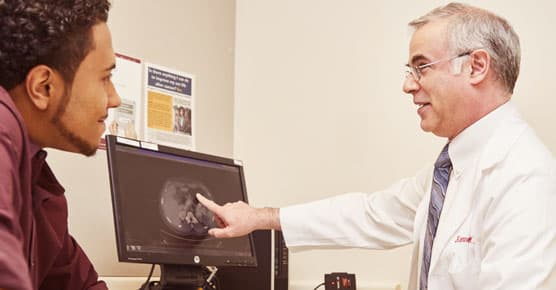Whipple Procedure: Frequently Asked Questions
The Whipple procedure, or pancreaticoduodenectomy, is the most common surgery for removal of cancer in the pancreas. Here are some answers to questions you may have about the procedure.
[MUSIC PLAYING] Surgery may be an option for patients with pancreatic cancer. The Whipple procedure is the most common surgery to remove cancer in the pancreas. This is also called the pancreaticoduodenectomy. The goal of the Whipple surgical procedure is to remove an entire tumor in the head or neck of the pancreas.
UChicago Medicine is one of few centers in the country that offer the Whipple procedure using both traditional open and robot-assisted techniques. An expert multi-disciplinary team of cancer doctors needs to go over every patient's case. The surgeon then discusses the risks and benefits with each patient to determine if the Whipple is right for them.
During the procedure, the surgical team removes the head of the pancreas. Then they remove the first portion of the small intestine, or duodenum, gallbladder, part of the bile duct, and nearby lymph nodes. In some cases, a small part of the stomach and portions of the nearby artery and vein may also need to be removed.
The final step is to reconnect the pancreas with the bile duct, stomach, and intestine so food can pass through the digestive system once again.
UChicago Medicine works to enhance recovery so patients can go home as soon as possible. Depending on the type and stage of the tumor, patients may undergo outpatient chemotherapy before or after surgery, or both. Because the Whipple surgery is a complex procedure, it's important to be treated by a highly experienced surgical team.
The American Cancer Society recommends patients have the Whipple operation at a hospital that does at least 15 to 20 of these surgeries per year. Surgeons at UChicago Medicine perform up to five times that many Whipple procedures annually. Want more information about pancreatic cancer and the Whipple procedure? UChicago Medicine is here to help.
Learn More About the Whipple Procedure
The Whipple surgical procedure involves removing the head of the pancreas (approximately 50 percent of the organ), first portion of the small intestine (duodenum), gallbladder, part of the bile duct, occasionally a small portion of the stomach (approximately 10 percent) and sections of nearby blood vessels. The goal of this complex surgery is to completely remove the tumor and all surrounding lymph nodes where cancer cells can spread. At the end of the procedure, the surgeon reconnects the pancreas, bile duct and small intestine to restore function in the digestive tract.
The Whipple operation was credited to an American surgeon, Allen O. Whipple, MD, in a 1945 report. On February 11, 1937, Alexander Brunschwig, MD, actually performed the first true anatomic resection with complete removal of the head of the pancreas while at the University of Chicago Hospital. This was performed as two sequential operations that preserved the entire stomach.
The Whipple procedure is the only potential curative surgery for pancreatic cancer.
Anyone who has been diagnosed with pancreatic cancer is potentially eligible for the Whipple procedure.
At UChicago Medicine, a group of oncologists, surgeons, radiologists, geneticists and pathologists with special expertise in pancreatic cancer meet to discuss every case. This team offers guidance about the best course of treatment for each patient.
If the Whipple procedure is recommended, you and your surgeon will decide if the treatment is right for you.
At UChicago Medicine, the Whipple procedure is performed using one of the following surgical techniques:
- The traditional open method requires an incision down the middle of the patient’s belly. Patients usually recover in the hospital for seven to 10 days.
- The minimally invasive robot-assisted method involves multiple small incisions. This may result in a shorter hospital stay and reduced pain and scarring.
Whether open or robotic, the Whipple procedure requires a high level of surgical training and excellent technical skills. UChicago Medicine has one of the most experienced teams of surgeons in the country performing the Whipple procedure.
Prior to your operation, the surgeon and anesthesiologist meet with you and your family in the preoperative holding area to answer any last-minute questions.
The anesthesia team takes you to the operating room, where they put you to sleep with intravenous (IV) medications. The anesthesiologist also places a breathing tube so you can get oxygen during the operation. The surgical team inserts special IV lines, a bladder catheter and a stomach tube (through your nose) after you are asleep.
Most patients wake up with a small tube in their nose to drain the stomach (after open surgery), an abdominal drain and a tube to drain from the bladder. These tubes are almost always removed before the patient leaves the hospital.
Following the surgery, you may experience pain from the incision. You can resume eating and drinking by mouth several days after surgery. At first, the stomach may not empty well, causing a bloated or full feeling. In some cases, medication is necessary to help your digestive system work properly. You may have a decreased appetite, which may take several weeks to improve.
Your care team at UChicago Medicine works to enhance recovery so patients can go home as quickly as possible.
Patients may choose to have a temporary regional anesthesia block, which helps reduce the need for narcotic pain medicine during the first 12 to 18 hours after surgery.
Postsurgical pain is initially controlled with either an epidural (spinal) catheter or a patient-controlled IV pain pump. Pain medicine specialists see hospitalized patients daily and work with your nurses and surgeons to ensure your pain is managed.
Medications can be taken by mouth after eating is resumed. Patients go home from the hospital with a limited supply of the appropriate pain pills.
Most patients do not need a feeding tube. It is generally best to eat a bland diet for the first several weeks after surgery. Nutritional supplements are sometimes helpful for improving strength and maximizing the healing process. Some patients will require enzyme pills taken with meals to replace what the pancreas normally makes. Patients receive instructions on how to maintain a proper diet (including recommended supplements) before leaving the hospital.
Complete recovery from the Whipple procedure can take up to two months. But in rare cases, it can take up to six months to recover.
Patients usually need to take a daily vitamin with iron and a daily medication to reduce stomach acid. Some patients temporarily have trouble regulating their blood sugar levels. Your doctor will determine if you need long-term medication to control blood sugar. Overweight patients and those with pre-existing diabetes may require insulin after their surgery.
It is important to get out of bed and begin walking the day after your operation. You should not lift anything heavier than a gallon of milk and avoid any strenuous physical activity for at least two months after your surgery. Please check with your surgeon before driving, working or participating in sexual activity.
Most patients return for a routine postoperative checkup within three weeks. It is common to see your surgeon every three to four months for the first two years and then every six months until year five and, after that, yearly for life.
Patients typically receive a total of six months of chemotherapy as part of their treatment. Prior to surgery, chemotherapy is given to shrink the size of the tumor and treat the entire body. If the patient received less than six months of chemotherapy before surgery, the remaining course is given after the patient has recovered from the operation. Patients who have a robot-assisted Whipple procedure may be able to continue their intended course of chemotherapy sooner, due to the shorter recovery time after this approach.
While there is no age limit for the Whipple procedure, age-related issues and conditions may impact a patient’s medical course and outcome. The geriatric oncology experts in the Specialized Oncology Care & Research in the Elderly (SOCARE) clinic assist our oncologic surgeons in evaluating older patients considering the procedure.
A pancreaticoduodenectomy is a major operation, but almost all patients survive the procedure. About one-third of patients may have a complication from the operation. Complications can be major or minor and can include bleeding, infection, clots, pneumonia and heart attacks. Your surgeon can manage most of these problems without having to perform another surgery.
Studies show that hospitals performing a high volume of Whipple procedures achieve a lower mortality rate than hospitals that perform few pancreatic resections. The American Cancer Society recommends patients have the Whipple operation at a hospital that does at least 15 to 20 of these surgeries a year. Surgeons at UChicago Medicine perform as many as five times that many Whipple procedures annually.

Cancer Care Second Opinions
Request a second opinion from UChicago Medicine experts in cancer care.

Participate in a Clinical Trial
UChicago Medicine pancreatic cancer experts are actively conducting clinical trials of new and promising treatments.

Cancer Pain Management
We offer a variety of treatments to effectively manage cancer pain.
Request an Appointment for Cancer Care
We are currently experiencing a high volume of inquiries, leading to delayed response times. For faster assistance, please call 1-855-702-8222 to schedule your appointment.
If you have symptoms of an urgent nature, please call your doctor or go to the emergency room immediately.
For Referring Physicians
To refer a patient for cancer care, please call UCM Physician Connect at 1-800-824-2282.
* Indicates required field
